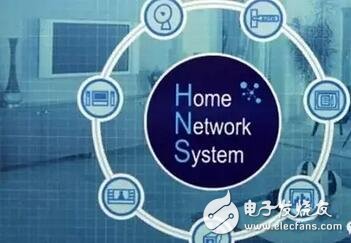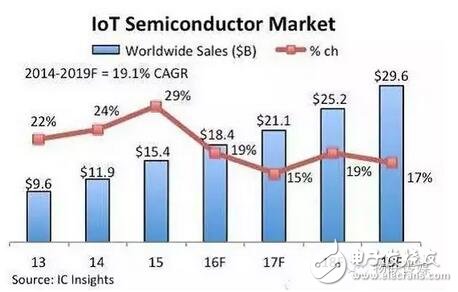According to a Morgan Stanley survey, 90% of the 117 semiconductor industry design technicians believe that the new Internet of Things trend is coming.
Considering that the average development cycle of new products in the Internet of Things is 1 year to 1 year and a half, even if the products are developed from now on, they will be completed from 2017 to 2018. Therefore, it can be expected that an unprecedented Internet of Things commodity frenzy will come between 2017 and 2018.
As the Internet of Things continues to grow and the demand for microcontrollers continues to soar, Morgan Stanley expects the semiconductor industry to reach $33 billion next year.
Morgan Stanley also expects the speed of the Internet of Things to increase from the current 8% to 18% in the next five years.
A number of IoT reports published by Morgan said that the Internet of Things will have a major impact on the future development of industrial automation, such as the US industrial software platform "Predix Cloud."

Despite the increase in the number of links, IC Insights has revised its forecast for the revenue of the Internet of Things semiconductors for the next four years, mainly considering that the sales performance of connected cities is not as good as expected.
Market research firm IC Insights pointed out that the number of connected devices in the world has grown significantly faster than the number of Internet users. Currently, the number of new Internet of Things (IoT) links is more than six times that of the Internet population. But despite the increase in the number of links, the agency has revised down its contribution to semiconductor revenues for the next four years to $1.9 billion, mainly because of the under-sales performance of connected city applications such as smart meters and infrastructure.
The latest forecast from IC Insights is that overall IoT semiconductor sales are expected to grow 19% in 2016 to reach $18.4 billion. However, the agency originally predicted that the composite annual average growth rate (CAGR) of the IoT semiconductor market between 2014 and 2019 would be 21.1%, but now it is revised to 19.9%; therefore, the size of the IoT semiconductor market in 2019 is estimated to be $29.6 billion, lower than Previously forecasted $31.1 billion.
The new figures come from projected changes in semiconductor revenues for connected city applications; IC Insights originally estimated that the CAGR for this type of application was 15.5% between 2014 and 2016, but now only 12.9%. However, the CAGR of IoT semiconductors in connected-vehicle applications increased from the original estimate of 31.2% to 36.7%.

It is estimated that by 2019, the sales of IoT semiconductors in connected cities will reach US$15.7 billion, and the sales of connected Internet applications for IoT semiconductors will be US$1.7 billion (previously forecasted at US$1.4 billion). In 2016, IoT semiconductor revenues for connected-connected cities are expected to grow by 15% to approximately $11.4 billion; while IoT semiconductor revenues for connected-line vehicles are expected to grow 66% to $787 million.
IC Insights also slightly revised its forecast for sales of IoT semiconductors for wearable systems; the application market grew by 421% in 2015 to reach $1.8 billion (mainly because Apple officially entered the smart watch market in the second quarter of 2015). ), it is estimated that sales in 2016 will grow by 22% to reach $2.2 billion. The wearable application IoT market is estimated to reach nearly $3.9 billion by 2019.
IC Insights' forecast for connected home and industrial IoT has not changed. It is estimated that the sales of connected home IoT semiconductor market will grow by 26% in 2016, reaching about 545 million US dollars, while the industrial IoT chip market can be It grew 22% to about $3.5 billion. In the industrial IoT semiconductor market, the CAGR is estimated to be 25.7% between 2014 and 2019, and the revenue can be increased from US$2.3 billion in 2014 to US$7.3 billion in 2019.
For the passed long time, the main sizes of laptops fell into three ones, 13 Inch Budget Laptop For Student, especially elementary or middle school or prefer smaller size; 17.1 inch graphic laptop for the ones prefer higher performance and bigger screen; 15.6 inch Budget Working Laptop for all others left. However, 14 Inch Laptop is becoming the main trend now, 11 Inch Laptop and 10.1 Inch Laptop also available at the market and our store.
14 Inch Gaming Laptop with i3, i5, i7 10th generation is a great choice for those who do heavy jobs and often go to business trip, like interior designers, engineering or architecture students or workers, etc. Of course, 14 Inch Laptop With Graphics Card, 16.1 inch i7 16gb ram 4gb graphics laptop also alternatives.
Of course, other Laptop 14 Inch I5 or 14 Inch To CM Laptop you can see also at this store. To save time, you can contact directly and share exact configuration so that we can provide right and valuable information quickly for you.
Except business, any we can do in China, just let us know also.
Not only want to cooperate, but also hope be your friend in China.
14 Inch Laptop,14 Inch Gaming Laptop,Laptop 14 Inch I5,14 Inch Laptop With Graphics Card,14 Inch To Cm Laptop
Henan Shuyi Electronics Co., Ltd. , https://www.sycustomelectronics.com